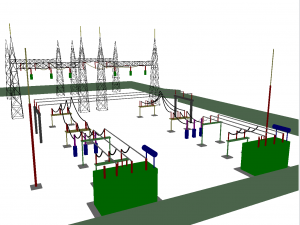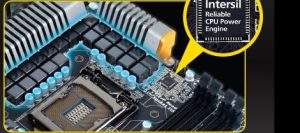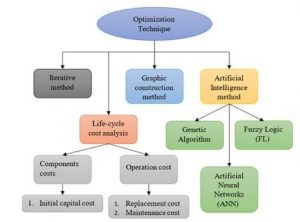
Embedded system components
What are the important parts of an embedded system? The important parts which are involved in embedded system are described below;
- Power supply
- Microcontroller
- RAM/ROM
- Timers and counters
- Communication ports
- Output/input
Power supply
Power supply is one of the main components of embedded system. It is mainly used to power the system without power supply the embedded system can’t start its working. Usually 5 volt of power supply is used which has range of about 1.8 to 3.3 v. A smooth and efficient power supply should be used for proper working of embedded system. The main source of power supply includes adapter, battery etc.
Microcontroller
An embedded system contains both microprocessor or microcontroller based systems. They give the system called integrated circuits. The brain of the embedded system is processor which is mainly responsible for the efficiency and performance of the embedded hardware. 8-bit, 16-bit, 32bit processor may be used in embedded systems. They are different from each other on the basis of speed of processor.
For example;
The 16-bit processor gives more speed and efficiency than 8-bits processor and has less speed and efficiency than 32-bits processor.
ROM/RAM:
Memory is one of the important components of embedded system. It is mainly used to store important information in the embedded system. Memory is integrated is on the microcontroller and microprocessor. Memory is divided into two mainly parts RAM (Randam access memory) and ROM (Read only memory). The data is temporarily stored in the memory of RAM as they have volatile memory. The data is lost in the memory of RAM if the system is switched off. The ROM memory is classified as code memory. When the system is switched on the embedded system fetch code from the memory of the ROM.
Timers and counters
The timers and counters is also the important part of the embedded system. The delay is required in some application of the embedded system.
For example;
One of the applications of the timers and counters is LED blinking. For the continuously blinking of the LEDs required delays. The delay is introduced in the embedded system by using programming. Crystal oscillator is used to decide the span of time delay and frequency.
Communication ports
Communication ports are one of the main important components of the embedded system. Through communication ports we can connect one embedded system to another embedded system. Different type of the communication ports are used in embedded system some of them describe there
- UART
- USB
- Ethernet
- RS-458
Communication ports of microcontrollers are used in the small scale application of embedded system. The serial protocol is used send data from one system board to another board.
Outputs and inputs
Without outputs and inputs embedded system is nothing. Every embedded system is required inputs to interact with other system. The inputs of the embedded system can be provided by sensor or by user itself. The inputs and outputs of the embedded system is depend on the processor of that embedded systems. The proper configuration is required for the inputs and outputs ports. In embedded system the different ports are fixed for different purposes
For example
P0, P1, P2, P3, P4, ………………

In embedded system there are many programs especially which is used for mobile application, battery power. The important thing is that the system disintegrates as slowly as possible while the required the function required the same power. Some few function of Algorithm is used to save energy. To reduced energy dissipation there are some strategies which has been made to minimize the function. The output level of VLSI architecture has different methods
- Architecture level
- Gate level
- Transistor level
- Structure level
During software installation algorithm the power dissipation of embedded system is overlooked. The batter use of instruction of CPU (central processing unit) is used to reduce energy dissipation. In this paper we learn the software upgrades strategies by different procedures. The example of command to linear code is the use of active phone. The modularity of codes less memory requirements are improved by the use of active phone
Software power optimization of embedded systems
As mention in the above paragraph, the power dissipation of embedded system will separate into two powers i:e power of hardware and power of software. Specific hardware app shows the combining effect of power. The power dissipated in CPU, memory, address and data busses all includes in latter. CMOS in this paper is the main implementation. Software power dissipation is the main source which work in the CPU, memory circuit and buses.

Bus power
Unidirectional and bidirectional address of busses steering data buses which is the group of the connecting wires when the memory and UO circuit connects with the processor. Like RC transmission line every line is done perfectly where R represents shortcuts and c represents power codes, Depending on the current and previous data, capacitor will start charging and discharging
For example
If the data will change from 00100101 to 10010010 in 8 bit data there are 6 changes
One more measure indicates the half and more total chip powering of 0.1 um USLI will take charging and discharging of bus lines. According to some estimate, the power of input and output data bus will increase up to 80%. There are some coding techniques (such as changing bus codes) minimize output change at the expense of minor maximize input change, to minimize overall power. We are making sure reducing such type of switching functions with an good source code.
THE POWER OF MEMORY:
The power loss in the memory may be plays an important role in the total power loss in the system. In the sub-program 11.50% of the power loss may be remembered. Memory capacity contains the big part of memory. Some of them were as follows:
✓ Energy lost in the list of cells.
✓ Power lost for charging and discharging lines.
✓ Power lost at the point of codes.
✓Distribution of power in the amplifier divided energy depends on the type of the memory. Consecutive memory access may be containing very low energy as the next word. One of them can expect that different type of address. In this case, the different type of page needed of some activation, which may be results in the additional power outputs. Unconventional access contains a large amount of energy; the name of the address may not be contains the address of last one. In the case of latter, the change of elevation in succession wills the great words.
✓ In the microprocessor of ARM, S-cycles, N cycles, or Cycles. S-cycles are the parts of CPU cycles which may leads to consecutive memory access, Non-sequential access leads to N-cycles, and internal cycles may be contains I-cycles where the external memory don’t have any connection.
CPU POWER:
The result of the every command of CPU will result the change of jobs. We can give instructions some of them were as follows:
✓Commands of load store
✓The instruction of branch
✓Arithmetic instructions of type 1 which may include addition, subtraction, shift etc.
✓Arithmetic instructions of type 2 which may include multiplication, division, opinion etc.
In this type of instruction the measurement of the power can be measured by maintaining the level of the gate or current calculate command level. Let’s say the weights corresponds related with the average power ratings for the four types of commands are W j, 1 <j <4 and the number of commands of these types are I j, then CPU power provided by 4.

APPLICATION ENVIRONMENT:
ADPCM algorithm is used as a performance vehicle show as settings of software power. ADPCM widely used in DECT (Digitally Enhanced Cordless Telecommunication) wireless in 1880-1900 MHz belt. ADPCM is a impediment of speech and reduced the algorithm. It will take the difference between sequences samples and record. We are as consider the ADPCM algorithm used as part of embedded system using an ARM processor. The ARM processor contains two sets of commands, A set of 32-bit ARM commands and a 16-bit set that is a type of pre-compressed. Decompressed orders during implementation to generate ARM instructions of 32 bits and it are used as usually.
TRACER:
The RAM is used by us. The tool kit of Software Development [11,12,13] the development of applications in the memory of the ARM family of microprocessors. The kit contains an accumulator that minimizes the application of launch in the ARM processor without access to the actual hardware. ARM and Thumb commands sets are the model of microprocessor. There are number of software modules provided with a tracer-like accumulator capable of tracking, Instructions included, memory type access, any other incidents that occurred during the murder. For example
Track can give us information about S-number cycles, N cycles, and I cycles.
The Assumption:
In the evaluating our software capabilities, we have done the following steps:
^ No pushing on buses
^One bus, two-way,
^DVD swipe full on bus switch,
^ On average, random access takes twice as much power compared to successive access
^When the CPU performs 8/16-bit functions in 32-bit data bus, will extract 0 from the remaining lines.
OPTIMIZATION TECHNIQUE:
Whenever, time and space given by ORM compiler for the performing of optimization of performance and code size It weren’t effective since suggestions were to make it at source code level. Some of them were as follow
- If these activities are coded on the line, and then this is more can be eliminated but at the expense of code upgrades size.
- Make a code @ spec @ instead of typing it normally inserting different data values, PCM rules etc.
- Code is made up of 32-bit data rates, the same rule PCM, and ITU-T recommended standard.
- Embedded code-programmed printing statements
- To eliminate unnecessary additions,
For example
Source Code % Producer I Emu! I 71 Code size
- This setting was used individually and then the effect on power, performance and code size was analyzed in both 32-bit ARM and 16-bit integrated code

ESTIMATION OF POWER:
- To measure the power of the bus, to switch between two consecutive names on 32-bit buses counted.
- Therefore, the total number of cy-Clock required to complete system (2N + S + I) clock cycles in the worst case scenario.
- Dispersed power is appropriation to [Total Conversion x (N + S + I) l (2N + S + I)].
- Power scattered in memory equal to (B.N + S) / (A.N + S + I), where B is a relative in the potential for non-sequential access compared to sequential access, A related length of non-sequential access within consecutive comparisons and access.
- In the worst cases, A can be 2.
RESULTS:
When one adjustment makes by the procedure after some may have un useful attachment between the data Therefore, it is important the order of preparation. Possible order can be try by the coordinator, but in the practice, commands to select-test discrepancy because of time limitation. The real ADPCM is changed for the each development program. The negative sign indicates that the setting removes-marks are a valid condition and therefore should not be as a source. Blending options of time and space de-marks compiler cannot working batter on the condition. Simultaneous for the better results we must use development strategies’
Conclusions:
In this paper, we have read several results resource level adjustment in performance, power, and embedded software code size. Our results show significant decrease power dissipation is possible by rewriting the code. When the producer makes one adjustment after some may have unwanted interactions between the data Therefore, the order of preparation is important.
Related Topics
-
What are the factors that Influence the selection of Embedded Microcontrollers?
-
How to do the software power optimization in embedded systems?
-
Revolution brought by Embedded Systems with Data Analytics
-
what are the practical applications of embedded systems?
-
what are the challenges in embedded systems design?
-
Discuss the stimulation study of Elevator’s control system
-
Embedded Systems Future: Design of optimized Energy Metering Devices
-
FPGA Based Data Recovery Method for Serial Communication